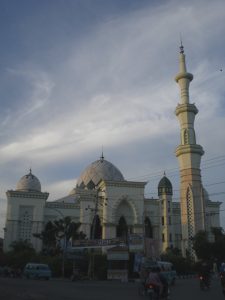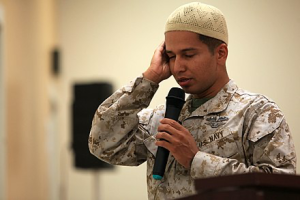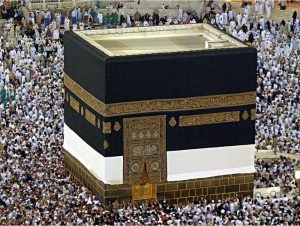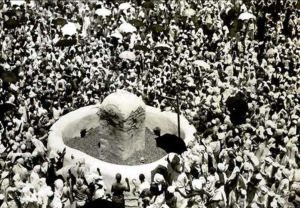69 Ritual, Material Culture, and Experience: Five Pillars of Islam
Muslims understand submission to God (Islam) as something that requires action. This is orthopraxy which means “correct practice”. What a person does is an important expression of his or her faith. These actions are called the Five Pillars of Islam and include:
- Witnessing one’s faith in God.
- Prayer five times a day.
- Charity, generosity to others.
- Fasting.
- Pilgrimage.
Each one of the five actions must be done with correct intention (niyya) to submit to God, and not as a source of one’s own pride.
Witnessing Faith, the Shahada
The main way that Muslims witnesses their faith is through the statement of faith called the shahada: “There is no God but God; Muhammad is his messenger.” Strictly speaking, the shahada is the orthodox expression of belief. But since it is included in many actions, it also has the quality of correct practice.
Prayer, Salat
Prayer, which is done five times a day, is a ritual act with clear rules. The prayer ritual is done in the early morning before dawn, at noon, in the mid-afternoon, at sunset, and in the evening. As we saw in the Narrative section, Muhammad in his experience known as the night journey negotiated with God the permission for his people to pray five times a day.
Shortly before the time for prayer, there is a “call to prayer” recited by a person assigned to this duty. His voice must be clear and loud enough for people to hear. The basic call consists of seven statements that are repeated:
God is most great (four times) I testify that there is no god but God (twice) I testify that Muhammad is the Messenger of God (twice) Hurry to prayer (twice) Hurry to salvation (twice) God is most great (twice) There is no god but God.
Before prayer one must wash to purify body and mind. Clothing should cover the body to the knees for men and the whole body except for face, hands and feet for the women. A person then focuses his or her mind on the intention of prayer worship. Finally, the person must face in the direction of Mecca. Lines on the floor of a mosque or house of worship indicate the correct direction.
A Muslim may pray at home or even outside, but the place must be clean and without distraction. Since prayer is done with prostrations (bows to the floor), usually a mat or rug is used when outside of a mosque. When prayer is done with others in a mosque or center, there are certain rules to follow. One person, called the imam, leads the prayers, standing at the front of the group. Everyone else forms lines, shoulder to shoulder. Women and men pray in separate areas, although all can see the imam.

The purpose or intention of prayer five times a day is to remind Muslims of God in the midst of their daily lives.

Giving Donations, Zakat
Prayer and generosity to others through giving away a portion of one’s wealth are the two major practices of Islam that began with the early communities in the seventh century CE. While prayer connects a person with God, donation connects a person with humanity.
Giving is required of Muslims: it is in the Shariah category of doing what God commands. Zakat is officially more like a tax than it is like charity. Charity can be optional, but zakat is not. One meaning of zakat is to “purify” one’s wealth. After giving, the remaining wealth is considered to be purified.
Traditionally, zakat is paid at harvest time for crops and at the end of the year for other goods. In Muslim countries it is collected by the government and distributed to the poor. The intention is first of all to obey God’s command. The act of giving, however, reminds Muslims of the religious belief that all one’s wealth in fact comes from God.
Fasting, Sawm
Once a year, during the month of Ramadan (ninth month) Muslims must fast from dawn to dusk. The ninth month is chosen because this was when Muhammad received his first revelation.
The fasting is more than limiting food. During the daylight hours Muslims refrain from eating, drinking, and sexual activity. All adults and teenagers must fast, but exceptions are made for pregnant and nursing mothers, elderly and sick people. At sunset, people gather for an evening meal.
The month of Ramadan is a special time of reaffirming one’s faith and community. Some people recite the Quran each evening, but universally, Ramadan evenings are a time for socializing. The month combines both piety and religious concerns with sociability.
For Muslims, the intention of the fast is to understand how one is dependent on God for the good things of the world. In addition, the fast makes one aware of the suffering of hunger and thirst that many experience in their lives. This develops empathy for others.
Pilgrimage, Hajj
The Hajj is a pilgrimage to the Kabah in Mecca. Once a year, the city is opened to Muslims from around the world to see and experience the places where Muhammad and the early Muslim community lived. For most Muslims in the world, going on pilgrimage to Mecca can only be a once in a lifetime event, due to the expense of travel and the time away from work.

Pattern of Ritual
Religious pilgrimages are essentially rituals, and share a common pattern across many religious traditions.
- Preparation: this may involve preparing special clothes for the pilgrimage, and usually includes some kind of study of religious texts. The person going on a pilgrimage prepares to separate from daily responsibilities and concerns.
- Liminal: this is the actual period of the ritual or pilgrimage. During this time, the person is separated completely from his or her usual activities and status in the community. The participant is in a state of ritual purity called ihram. A feeling of oneness between all the participants develops as people move through the different locations of the pilgrimage. Usually, special clothes are worn and special foods or a limitation on eating and drinking is part of the pilgrimage.
- Return: the person returns to ordinary life and responsibilities, but often with a higher status for having undergone this special activity.
Events of the Hajj
The Hajj was established by Muhammad before his death. He organized the order of the Hajj to commemorate certain events of his life and the life of the prophet Abraham and his family.
Entering Mecca
The pilgrims, wearing simple white clothing, enter Mecca chanting: “I am here, O my God, I am here I am here, Thou art without any associate, I am here Praise and blessing belong to Thee, and Power.” (Denny 2006, 122)
They then go around the Kabah, a cubical building, circling it seven times counterclockwise. Each pilgrim will perform this part of the ritual three times during the Hajj.
Honoring Abraham and his family
Pilgrims then pray at a sacred space that is supposed to be where Abraham prayed when he built the Kabah thousands of years ago.
Next, the pilgrims go to nearby hills where Hagar, the exiled consort of Abraham, searched for water. The story is that when God commanded Abraham to send Hagar away with Ishmael, she came to this desert area. Desperate for water, she ran between these two hills, searching until God revealed a spring known as the Well of Zamzam. Pilgrims run-walk between these two hills to commemorate this event.
The pilgrims then go to the Plain of Arafat where they meditate on the command to sacrifice Ishmael that Abraham received from God. They stand from noon until sundown, silently meditating. At sundown, they travel to another plain where they throw small stones at a pillar meant to represent the devil who whispered to Ishmael to escape.

The pilgrims then sacrifice animals to symbolize the sacrifice of the ram that Abraham made in lieu of sacrificing his own son.
Ending Pilgrimage
The official pilgrimage ends after the sacrificial feast. It is customary for pilgrims to cut their hair and nails for purification to show that they have successfully completed the Hajj. You may watch the hour-long documentary Inside Mecca, produced by National Geographic, by clicking the following link. Link
This description of the five pillars of Islam illustrates how ritual is enacted through material culture by giving donations, praying at a mosque with others, and re-enacting events of the life of the prophet through the pilgrimage of the Hajj. The power of narrative and ethics are woven throughout these ritual actions and objects that produce powerful experiences of community and humilty in submission to God.
